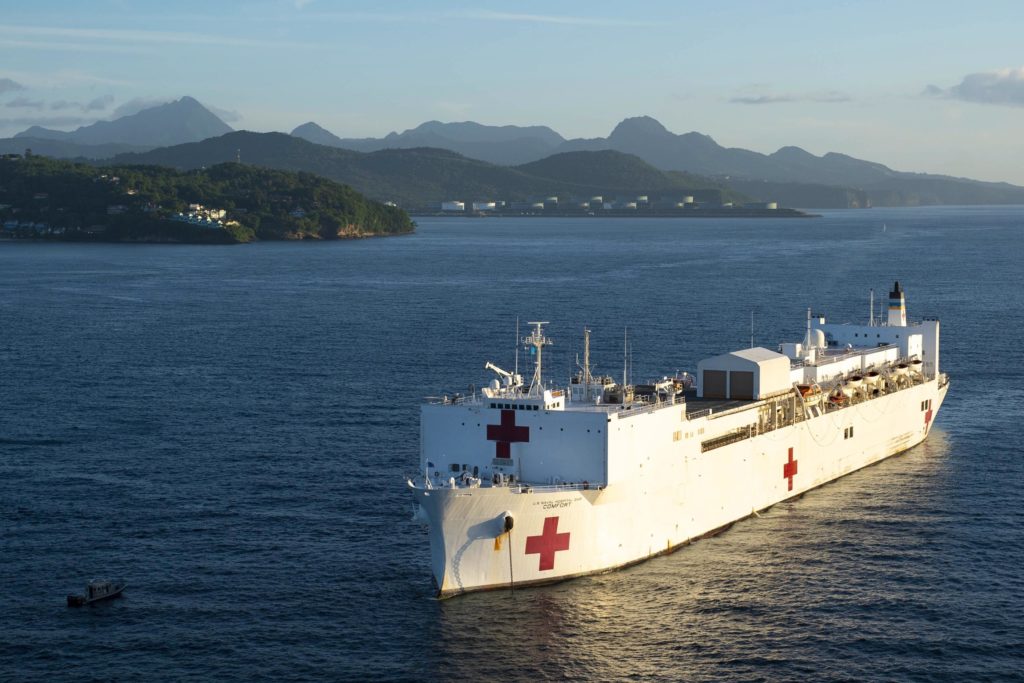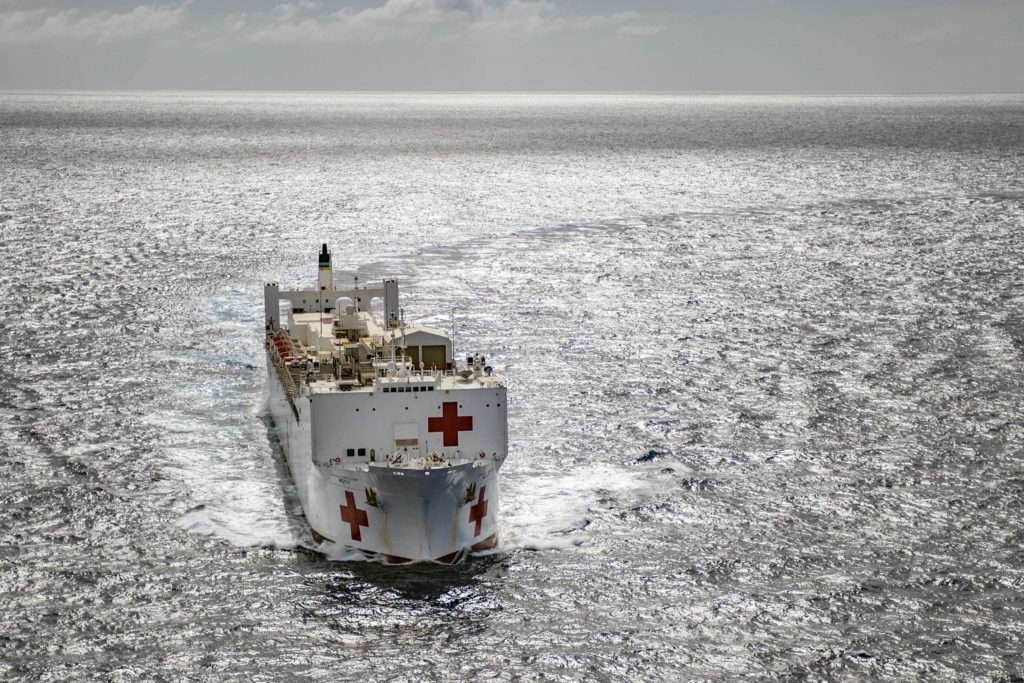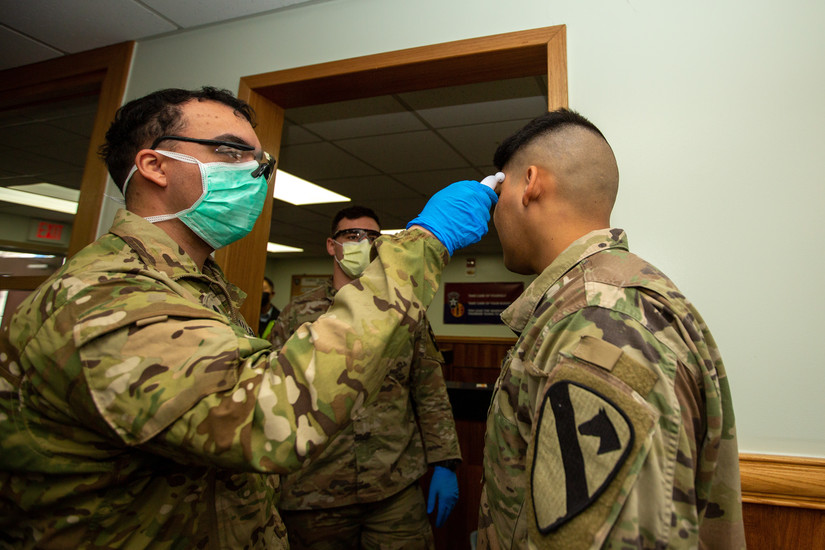
UPDATE II:
The US Navy hospital ship USNS Comfort (above) will be dispatched to New York Harbor after undergoing preparations.
The second Navy hospital ship, the USNS Mercy (below) is being prepared to deploy to a location on the West Coast.

UPDATE I: Please read USA Today’s “Enlist the US military and its unique skills in the home front war against coronavirus”:
The US military has deployed to disasters and health crises across the globe. It makes sense now to use this capability to respond to crisis at home.
The military, with over 1.3 million men and women in uniform, trained to deal with high stress situations, tens of thousands of aircraft, hundreds of thousands of vehicles, extensive medical facilities both fixed site and expeditionary, and an annual budget of nearly $740 billion, can mobilize resources unmatched by any civilian organization.
Original Post:
On Feb 28, two days after the nation saw the first possible U.S. coronavirus case of “community spread,” and just one day before the first death due to the virus in the United States, we looked at “How the Pentagon [Was] Dealing with the Coronavirus.”
As mentioned, with 200,000 U.S. military deployed around the globe and on the high seas, they and their dependents are especially exposed to COVID-19, the novel coronavirus raging abroad.
Around that time, a 23-year-old soldier serving with U.S. Forces on the Korean Peninsula became the first U.S. service member diagnosed with the virus.
The coronavirus pandemic has spread to more than 140 countries, sickening more than 187,100 people and killing almost 8,000.
As of this writing, at least 5,303 people in 49 states, plus Washington, D.C., and three U.S. territories, have tested positive for the coronavirus, according to a New York Times database, and at least 96 patients with the virus have died.
How is the pandemic affecting our military, its readiness and what precautions is the Pentagon taking to protect its forces? Perhaps equally important, what role is, or could, the military (be) playing in protecting the American people from this unprecedented danger.
Here are some facts and thoughts.
According to military.com, as of March 16, there were 59 cases of COVID-19 within the DoD: 36 military, 12 dependents, 8 civilians and 3 Defense Department contractors. The Pentagon says the number of military cases has doubled in just one day.
The number of military members affected by the virus include Army, Navy, Air Force and Marine Corps personnel.
A sailor assigned to the amphibious assault ship Boxer tested “presumptive positive” for the new strain of coronavirus, marking the first case for a sailor on board a Navy ship and the second known patient from Naval Base San Diego, according to The Navy Times.
Veterans are not being spared.
On March 14, the Department of Veterans Affairs announced the first VA-connected fatality due to coronavirus. VA hospitals have started barring all visitors.
The VA is tracking five confirmed positive coronavirus cases among veterans, and 25 presumptive positive cases, awaiting testing confirmation from the CDC.
DoD has administered 495 coronavirus tests and the VA has administered more than 322 to date.
In Italy, severely hit by the virus, a second Italy-based U.S. sailor has been infected with the coronavirus and 20 more service members are being monitored there and in Spain for the virus.
In Germany, (Stars & Stripes) A third person connected to the military community in Stuttgart has tested positive for the coronavirus, and about 100 people are in self-isolation awaiting virus test results.
The military has for weeks been preparing for the coronavirus.
Some of the most recent actions:
While the Pentagon eased travel restrictions in South Korea as coronavirus cases eased, on March 13 DoD issued global stop-movement orders for all U.S. military personnel, and military family, including PCS (permanent change of station) and TDY (temporary duty).

Several (joint) training exercises are being cut back, curtailed, postponed or cancelled:
(Army Times) U.S. officials are significantly reducing the size and scope of the long-awaited Defender 2020 exercise intended to test the Army’s ability to move a division-sized force from U.S. seaports to European training grounds this spring.
The Marine reserves will no longer conduct monthly drills for non-essential personnel
(Navy Times) Navy postpones drill for most reservists for two months
(Army Times) U.S. Africa Command announced Monday that the upcoming, multinational exercise African Lion will be canceled to safeguard against the spread of COVID-19.
The remaining portion of the major Arctic joint exercises dubbed Cold Response has been canceled over coronavirus fears. The exercise included roughly 15,000 troops from the U.S., Norway and eight other allied countries.
Finally, as several governors are activating their National Guard Units to help deal with the growing coronavirus pandemic, the question arises as to how the military can help (more) in this area.
The Pentagon is already taking other steps to help respond to the pandemic within the United States. The Secretary of Defense said the military would provide the Department of Health and Human Services (HHS) with five million respirator masks and other personal protective gear and will also provide HHS 2,000 specially designed deployable ventilators.
Teams of Army researchers are helping to develop a vaccine and other countermeasures for the virus at installations around the country, including Fort Detrick and the Walter Reed Army Institute of Research, both in Maryland.
Can the military be used in additional ways?
Should they build hospitals? Provide field hospitals, hospital ships*, equipment, doctors, medical personnel?
Could they be used to enforce curfews, lockdowns and quarantine? (But keep in mind the Posse Comitatus Act)
Should the government reauthorize the Defense Production Act?
Please read here and here for the pros and cons.
Sources: The Stars and Stripes; Military Times; Army Times, Navy Times
* USNI has reported, the Pentagon is starting the process of activating Navy hospital ships USNS Mercy and USNS Comfort as part of the Defense Department’s domestic response to the spreading COVID-19 virus
















